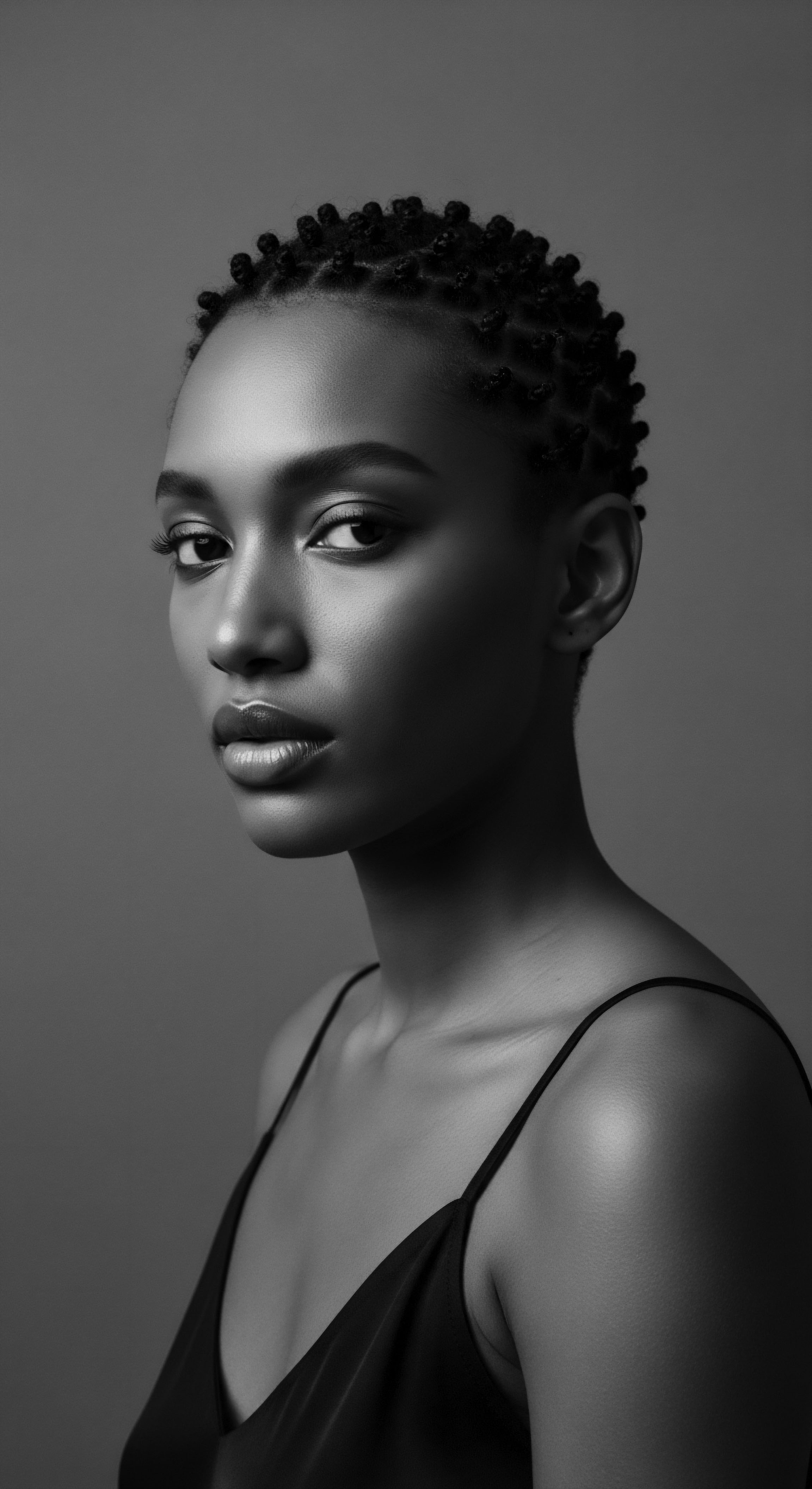
Fundamentals
Within the sacred archives of Roothea, where every strand whispers tales of ancestry and resilience, the concept of Hair Length Retention stands as a foundational pillar. This term, in its most elemental interpretation, refers to the capacity of hair, particularly textured hair, to maintain its physical dimension as it grows from the scalp, resisting the forces that might otherwise diminish its visible span. It is not merely about the rate at which hair elongates from the follicle, but rather the collective triumph over breakage, shedding, and environmental stressors that often truncate the journey of a hair strand.
The understanding of Hair Length Retention begins with a recognition of the hair growth cycle itself, a biological rhythm shared by all human beings. Yet, for those bearing the rich heritage of textured hair, this journey often presents distinct considerations. The coiled and curled architecture of these strands, while possessing immense strength and beauty, also renders them susceptible to unique vulnerabilities.
Each bend and curve in the hair shaft represents a potential point of fragility, a place where mechanical stress or dryness can lead to fracture. Thus, the meaning of Hair Length Retention for textured hair extends beyond simple measurement; it encompasses the preservation of the strand’s integrity from root to tip, allowing its natural growth to be visibly realized.
Hair Length Retention for textured hair is a testament to the enduring strength and unique needs of coily and curly strands, honoring their journey from follicle to full expression.
From the earliest communal gatherings, ancestral peoples understood, through observation and inherited wisdom, that certain practices encouraged hair to reach its fullest expression. This rudimentary comprehension of Hair Length Retention, though perhaps not articulated in scientific terms, was deeply embedded in daily rituals and communal lore. They recognized that a strand preserved was a strand celebrated, reflecting vitality and connection to the earth’s rhythms. The early definitions of care were practical, centered on protection from the elements and the nourishment drawn from the land.
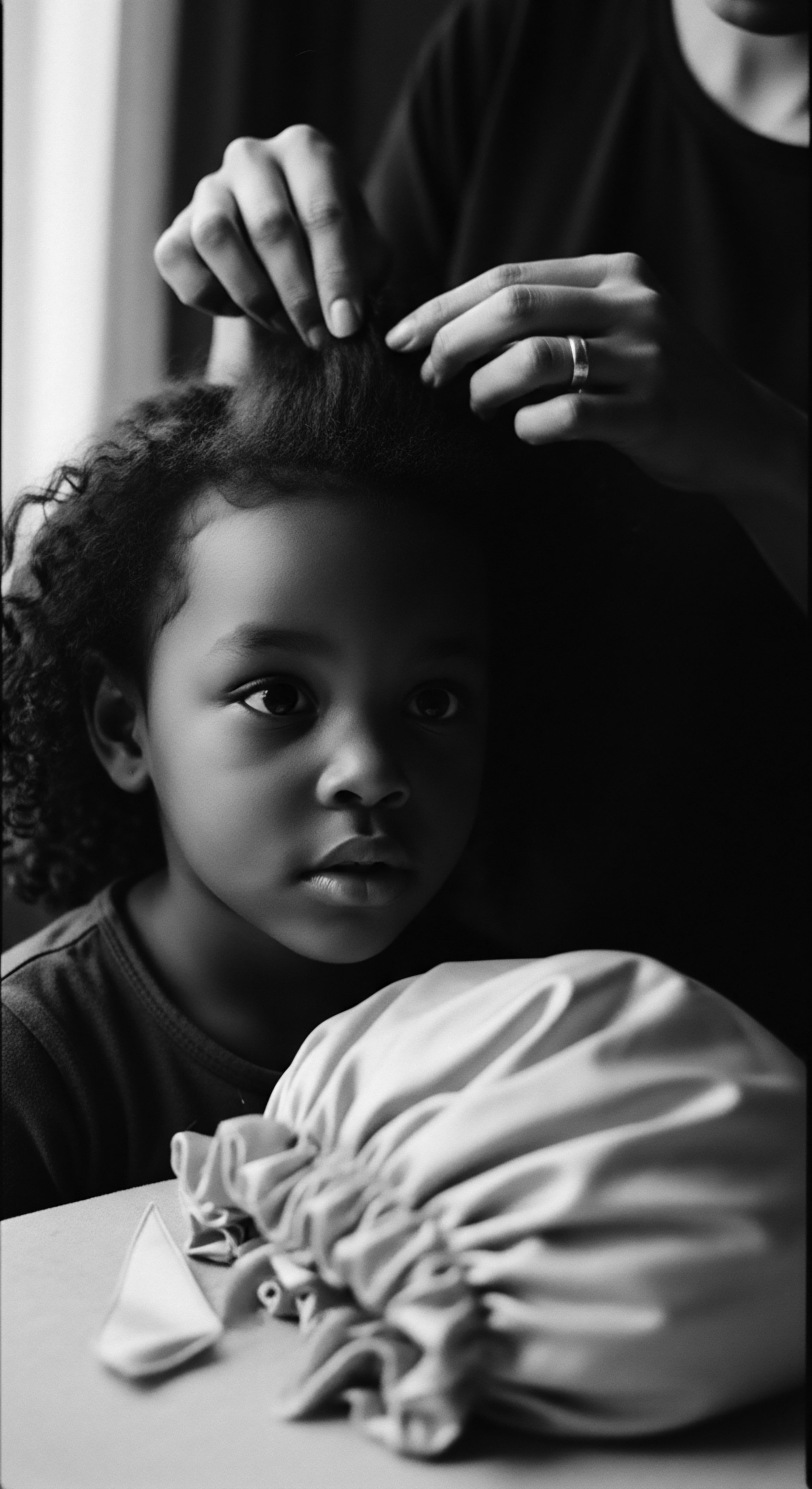
The Early Whisperings of Care
The foundational knowledge of Hair Length Retention, passed down through generations, was intrinsically linked to the natural world. Ancestors observed the resilience of certain plants, the protective qualities of natural oils, and the gentle strength of fibers. These observations translated into rudimentary yet remarkably effective methods of hair care, all aimed at allowing hair to reach its inherent length.
- Protective Styling ❉ Early communities instinctively recognized the benefit of gathering hair into braids, twists, and knots. These styles, far from being mere adornment, served a practical purpose ❉ shielding delicate strands from the harsh sun, drying winds, and daily friction. This ancestral wisdom laid the groundwork for modern protective styling, a cornerstone of length preservation.
- Natural Lubricants ❉ The application of animal fats, plant butters, and oils—such as shea butter, palm oil, or coconut oil, depending on regional availability—provided a protective barrier. These substances helped to seal moisture within the hair shaft, reducing brittleness and making the hair more pliable, thereby decreasing the likelihood of breakage.
- Gentle Handling ❉ The slow, deliberate movements involved in ancient hair rituals, often performed within communal settings, inherently promoted gentle handling. This contrasts sharply with the often hurried and aggressive methods of modern detangling, highlighting an ancestral reverence for the strand’s delicate nature.
The significance of Hair Length Retention in these early contexts was not merely aesthetic. It was often intertwined with social status, spiritual beliefs, and community identity. Long, healthy hair could signify maturity, wisdom, or a connection to the divine.
The ability to retain length was a tangible manifestation of sustained care and ancestral blessing, a living legacy worn upon the head. This deep-seated understanding forms the bedrock upon which all subsequent knowledge of Hair Length Retention is built, reminding us that its origins are as ancient and enduring as the strands themselves.
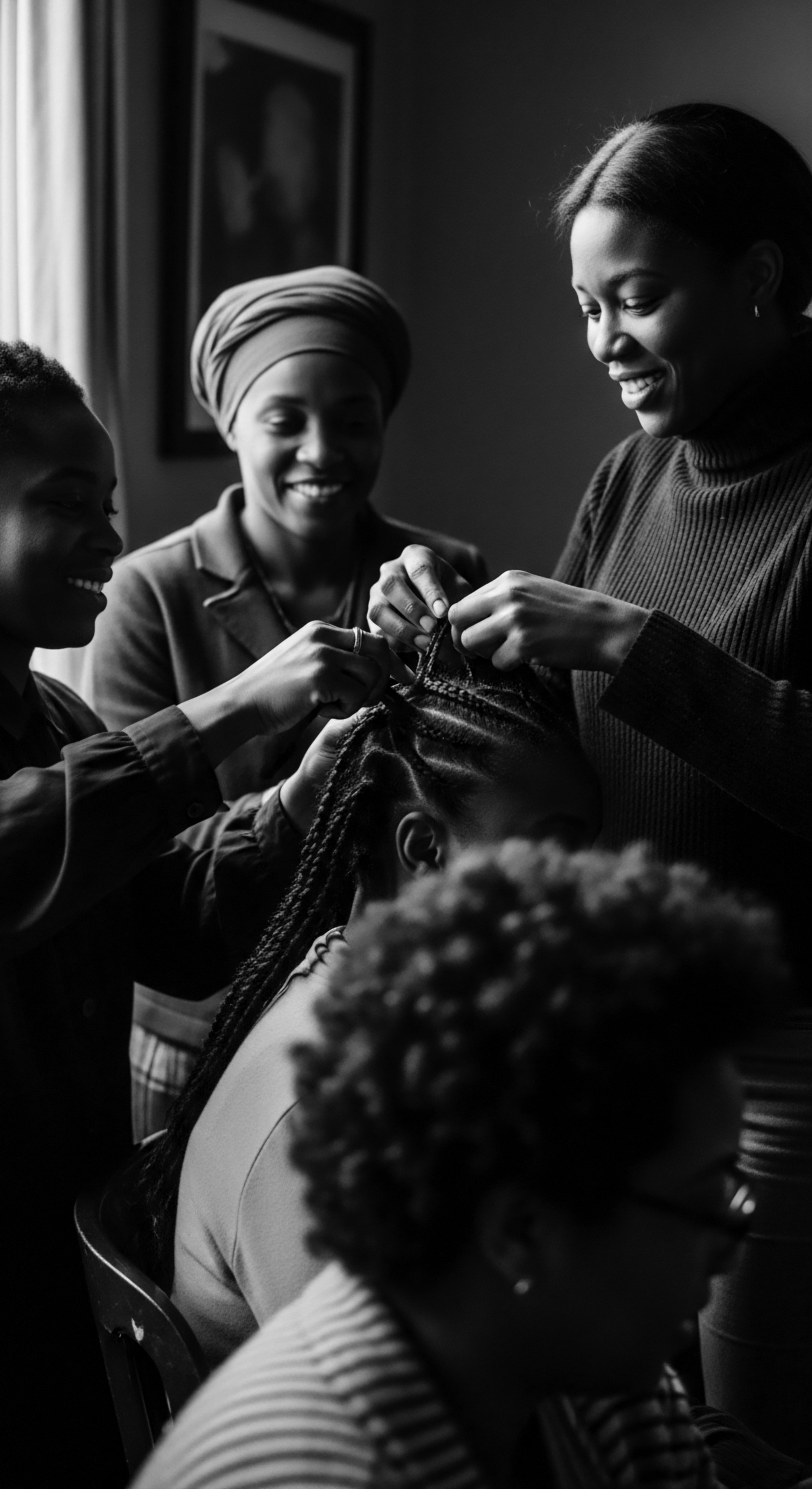
Intermediate
Moving beyond the foundational tenets, an intermediate understanding of Hair Length Retention necessitates a deeper exploration into the specific physiological and environmental factors that govern the journey of textured hair from its genesis in the follicle to its visible maturity. Here, the definition of Hair Length Retention expands to encompass the complex interplay between internal biological processes and external care practices, all viewed through the lens of heritage and the unique challenges faced by Black and mixed-race hair. It is not a passive process, but an active, continuous engagement with the hair’s needs, often informed by centuries of communal wisdom.
The anatomical structure of textured hair, characterized by its elliptical cross-section and distinct curl patterns, presents a particular challenge to length retention. The cuticle layers, which serve as the hair’s protective outer shield, are often raised at the curves of a coiled strand. This inherent characteristic renders textured hair more porous, making it prone to moisture loss and, consequently, increased fragility.
The greater number of bends and twists also means more points of contact with neighboring strands and external surfaces, amplifying the potential for tangling and mechanical abrasion. Understanding this intrinsic vulnerability is paramount to appreciating the deliberate and often labor-intensive care rituals developed over generations to preserve length.
The intricate geometry of textured hair, while a source of profound beauty, also presents unique challenges to length retention, requiring intentional and informed care practices.
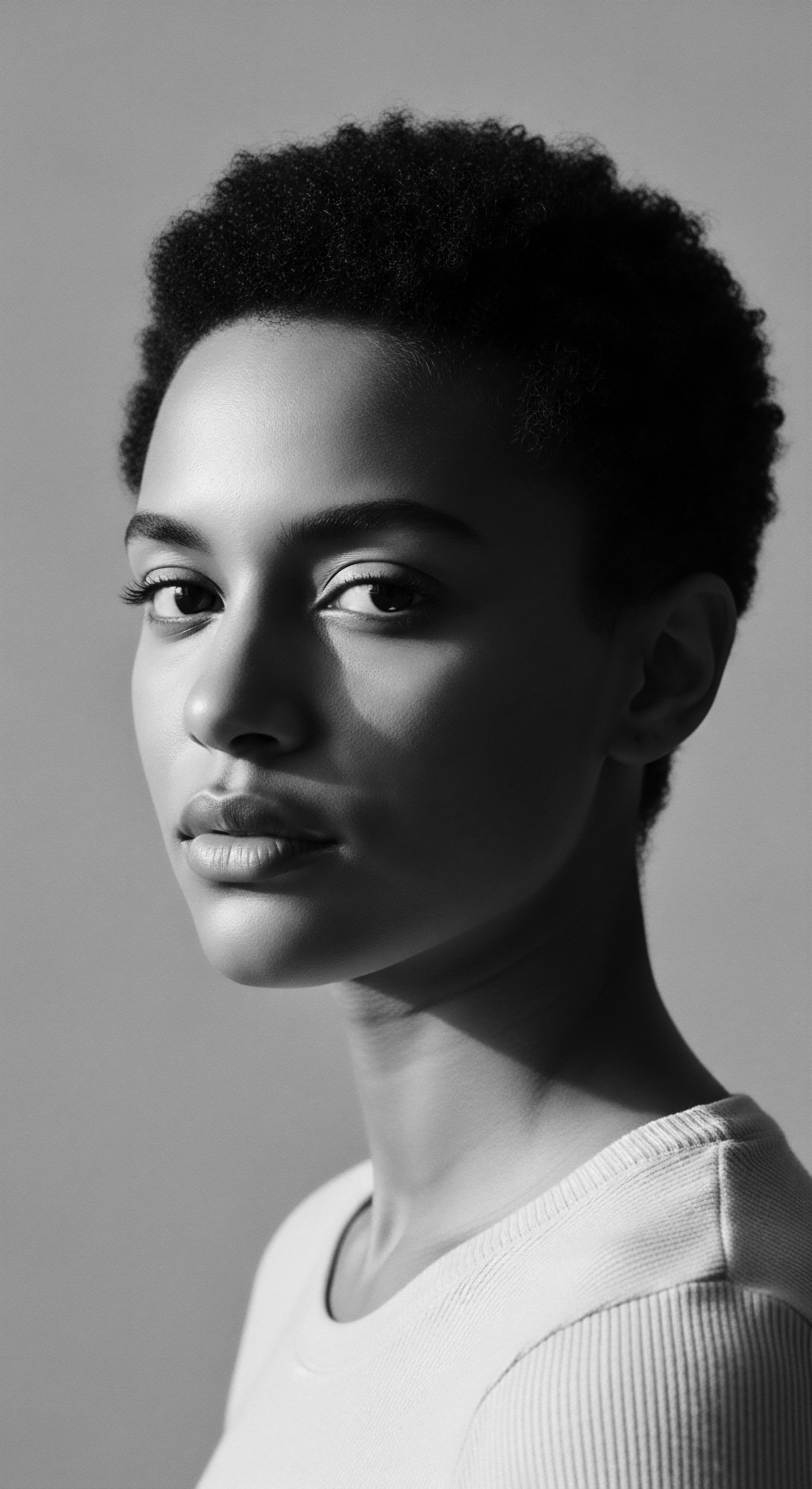
The Legacy of Protection and Nourishment
The practices of our ancestors, born of necessity and deep observation, offer profound insights into effective Hair Length Retention. These traditions were not random acts but sophisticated systems of care, honed over centuries, that addressed the specific needs of textured hair long before modern science articulated the mechanisms. The meaning of Hair Length Retention, in this context, is inextricably linked to the intentional application of protective measures and nourishing ingredients.
Consider the historical prevalence of scalp oiling and hair greasing across various African and diasporic communities. This was not merely for shine; it was a deliberate strategy for Hair Length Retention. Oils and butters formed a hydrophobic layer on the hair shaft, reducing water evaporation and helping to keep the hair pliable. This ancestral wisdom of sealing moisture is now validated by contemporary hair science, which acknowledges the role of emollients in reducing hygral fatigue—the weakening of hair from repeated swelling and contracting due to water absorption and loss.
| Ancestral Practice Braiding & Coiling (e.g. Bantu knots, cornrows) |
| Contemporary Interpretation / Scientific Link Protective styling minimizes manipulation, reduces friction, and shields ends from environmental damage, thereby preserving length. |
| Ancestral Practice Herbal Rinses & Infusions (e.g. Chebe, Ayurvedic herbs) |
| Contemporary Interpretation / Scientific Link Strengthens hair shaft, improves elasticity, and reduces breakage. Many traditional herbs contain mucilage or proteins that coat and fortify the hair. |
| Ancestral Practice Natural Oils & Butters (e.g. Shea, Palm, Coconut) |
| Contemporary Interpretation / Scientific Link Emollients and sealants reduce moisture loss, enhance pliability, and provide a protective barrier against mechanical stress and environmental factors. |
| Ancestral Practice Communal Hair Care Rituals |
| Contemporary Interpretation / Scientific Link Fosters gentle handling, knowledge transfer, and consistent care, reducing individual neglect and promoting healthy hair habits. |
| Ancestral Practice The enduring wisdom of ancestral practices for Hair Length Retention continues to resonate with modern scientific understanding, bridging past and present care. |
The communal aspect of hair care in many ancestral societies also played a quiet yet powerful role in Hair Length Retention. Hair dressing was often a social ritual, a time for bonding and the intergenerational transfer of knowledge. In these shared spaces, children learned from elders the delicate art of detangling, the proper application of nourishing concoctions, and the patience required for consistent care. This collective vigilance against damage and neglect contributed significantly to the visible length achieved by individuals within the community.
The cultural significance of hair, often symbolizing lineage, status, or spiritual connection, provided a powerful incentive for its meticulous preservation. The meaning of length retention was therefore woven into the very fabric of social interaction and identity.
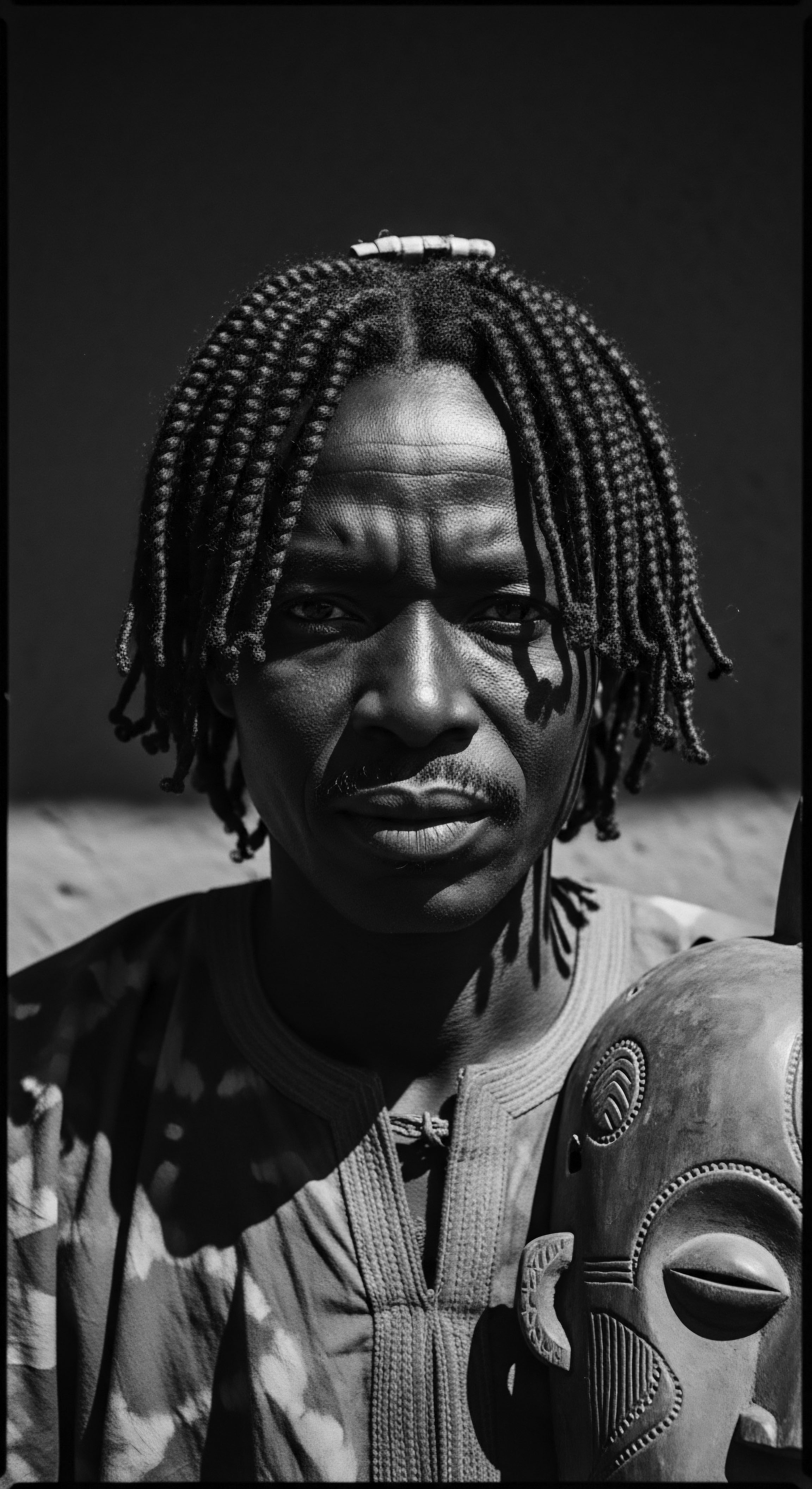
Academic
The academic elucidation of Hair Length Retention transcends rudimentary explanations, positioning it as a complex bio-cultural phenomenon, particularly within the context of textured hair. This scholarly interpretation recognizes Hair Length Retention not merely as a biological outcome, but as a deeply embedded socio-historical construct, shaped by genetics, environmental exposures, cultural practices, and the enduring legacy of ancestral knowledge. The definition here encompasses the intricate interplay of hair shaft morphology, follicular biology, mechanical stress, chemical interventions, and the profound psychosocial implications of hair health and visible length within Black and mixed-race communities. It is a critical examination of how hair’s inherent capacity for growth is either realized or inhibited by a confluence of factors, many of which are historically and culturally contingent.
From a trichological perspective, the sustained achievement of visible hair length hinges upon the successful navigation of the hair growth cycle’s anagen (growth) phase, coupled with minimal premature entry into the catagen (transitional) and telogen (resting) phases. For textured hair, the inherent structural characteristics—namely, the elliptical cross-section, the tight helical coiling, and the irregular distribution of disulfide bonds—render the cuticle more susceptible to abrasion and fracture. This architectural predisposition means that even a healthy anagen phase can be undermined if the distal portions of the hair shaft are not adequately protected from mechanical stress, dehydration, and chemical damage. The challenge, then, is not solely to stimulate growth, but to fortify the existing length against degradation.
Hair Length Retention for textured hair is a complex bio-cultural triumph, reflecting the intricate dance between inherent biological predisposition and the deliberate, historically informed strategies of care.
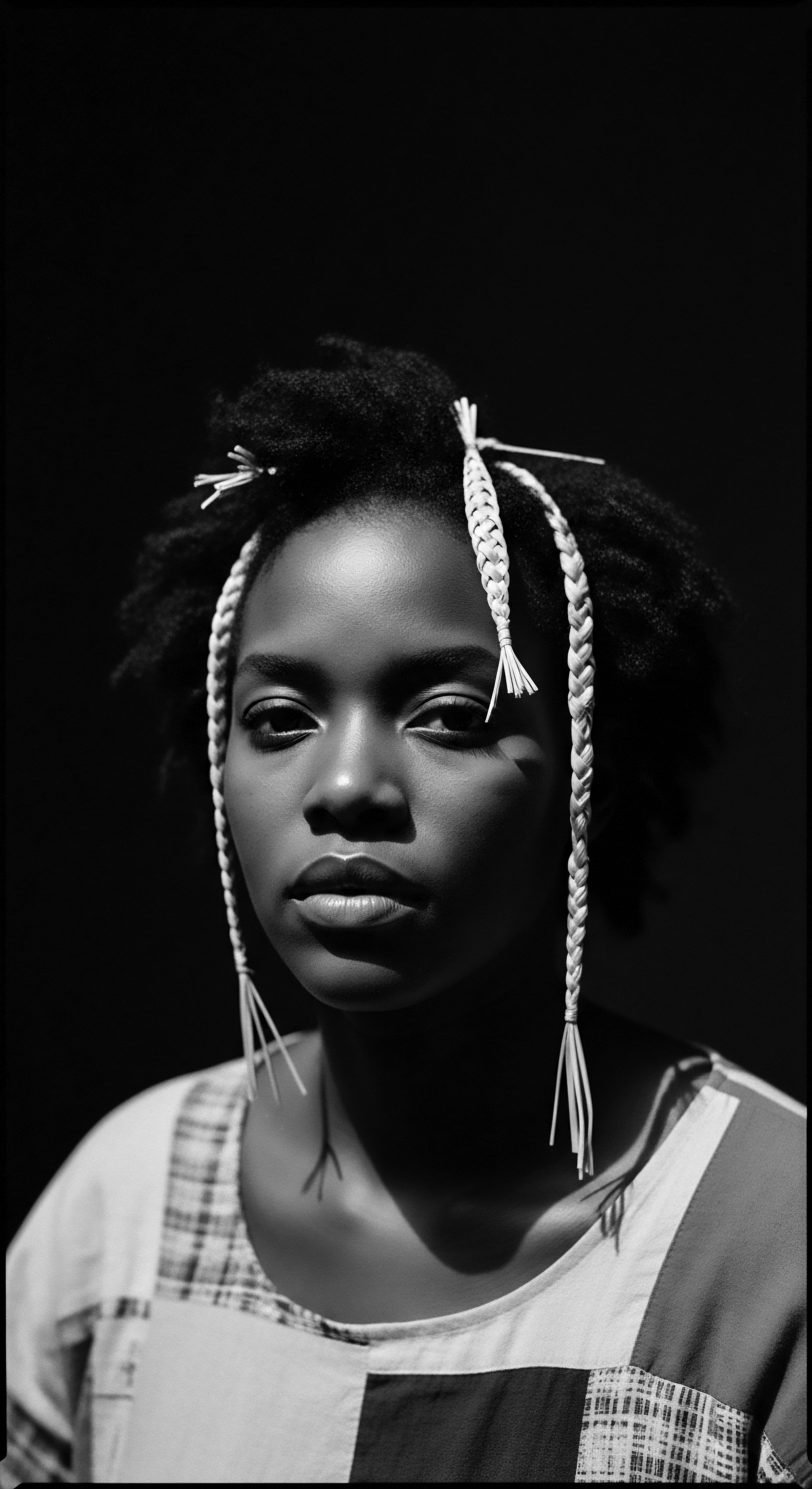
Ancestral Wisdom and Modern Validation ❉ The Chebe Tradition
To truly comprehend the profound meaning of Hair Length Retention in a culturally grounded academic sense, one must turn to specific ancestral practices that have demonstrably supported this outcome for generations. A compelling example is the Chebe Tradition of the Basara Arab women in Chad, Central Africa. This practice offers a powerful case study in indigenous ethnobotany and its direct impact on Hair Length Retention, serving as a living testament to sophisticated ancestral knowledge often predating modern scientific understanding.
The Chebe ritual involves a finely ground mixture of local plants, primarily Croton Zambesicus (also known as Lavender Croton), along with other ingredients like Mahllaba, Misik, Cloves, and Samour resin. This powder is traditionally mixed with oils or butters and applied to the hair, usually after braiding or twisting, creating a protective coating that is left on for extended periods, often days or weeks, between washes. The women of the Basara community are renowned for their floor-length, healthy hair, which they attribute directly to this meticulous practice.
The unique angle here lies in the mechanism by which Chebe appears to facilitate Hair Length Retention. Unlike treatments aimed at stimulating follicular growth, the Chebe tradition focuses primarily on strengthening the existing hair shaft and preventing breakage. The powder, when applied, forms a cohesive layer around the hair strands. This coating acts as a physical barrier, significantly reducing friction between individual hair fibers and against external elements.
It also helps to seal in moisture from the oils or butters used in conjunction with it, mitigating the porosity challenges inherent to textured hair. The saponins present in some of the Chebe ingredients may also contribute to a cleansing effect without stripping the hair, further preserving its integrity.
This practice provides a profound illustration of how ancestral knowledge directly addressed the critical bottleneck in textured hair growth ❉ breakage. While hair grows from the scalp at a consistent rate, visible length is often compromised by the rate of breakage exceeding the rate of growth. The Chebe tradition, through its emphasis on protective coating and reduced manipulation, effectively shifts this balance, allowing the naturally growing hair to accumulate visible length.
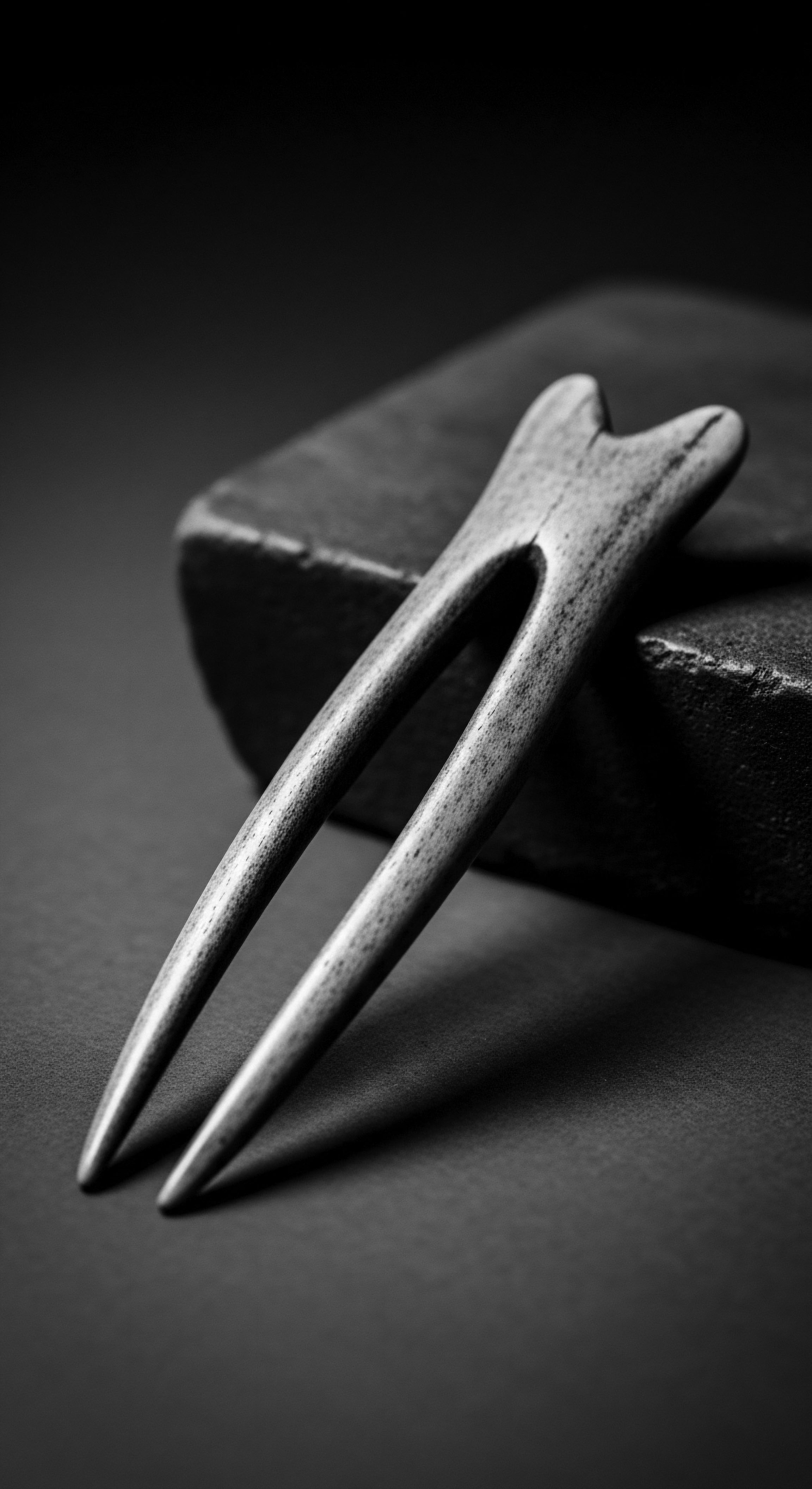
Sociocultural Dimensions of Chebe and Length Retention
Beyond the biophysical mechanisms, the Chebe tradition also illuminates the sociocultural dimensions of Hair Length Retention. The ritual itself is a communal activity, often performed by women for each other, fostering bonds and transmitting cultural heritage. The visible length achieved through this practice is not merely an individual aesthetic choice; it is a marker of cultural identity, adherence to tradition, and a symbol of beauty and resilience within the Basara community.
The practice underscores how Hair Length Retention is not a solitary pursuit but can be deeply embedded within collective identity and ancestral pride. This collective investment in hair health, passed down through generations, creates a reinforcing cycle where cultural value drives consistent care, which in turn leads to visible length.
A study by Diala, I. (2018), exploring the traditional hair care practices of women in Chad, notes the deep cultural significance of long hair and the consistent application of Chebe powder as a primary method for achieving it. The research indicates that the women view their hair length as a direct result of their adherence to these ancestral methods, emphasizing the role of the protective coating in preventing environmental damage and mechanical breakage. This empirical observation from anthropological study provides a rigorous backing to the claims of Hair Length Retention achieved through traditional practices, highlighting how the “why behind what” is often rooted in centuries of lived experience and effective indigenous science.
The enduring success of the Chebe tradition offers a powerful counter-narrative to the often-Eurocentric perspectives on hair care, which historically overlooked or pathologized textured hair. It demonstrates that sophisticated, effective strategies for Hair Length Retention existed and flourished within African communities, born from a deep understanding of the hair’s unique needs and the local botanical environment. This academic lens allows us to appreciate Hair Length Retention not just as a personal hair goal, but as a tangible manifestation of cultural continuity, resistance, and the vibrant legacy of ancestral wisdom in the face of historical and ongoing challenges.
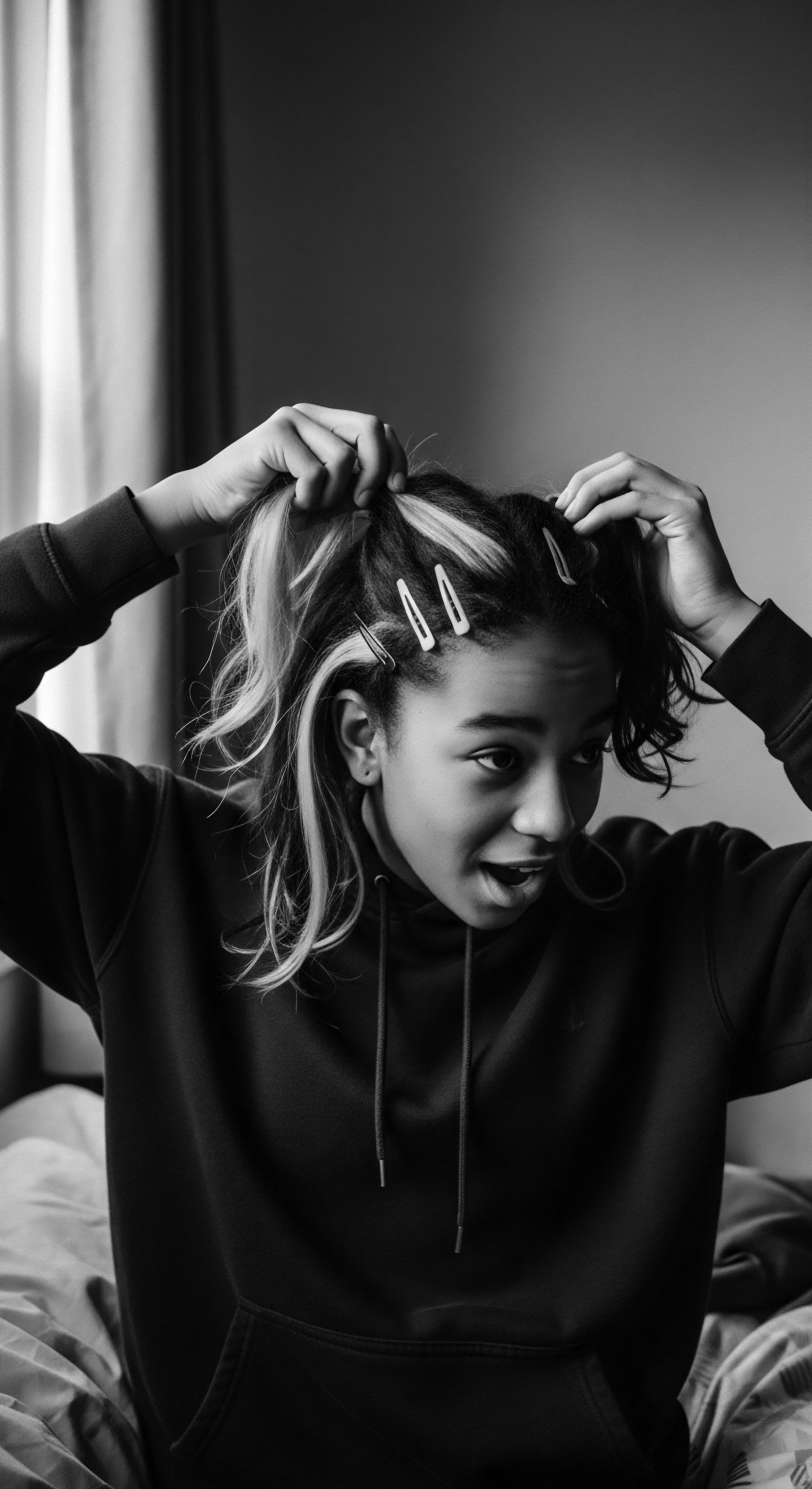
Reflection on the Heritage of Hair Length Retention
As we journey through the intricate layers of Hair Length Retention, from its elemental biological stirrings to its profound cultural resonance, we come to recognize it as far more than a simple metric of growth. It is a living, breathing testament to the enduring spirit of textured hair, a silent chronicler of ancestral wisdom, and a vibrant declaration of identity. Each millimeter gained, each strand preserved, whispers echoes from the source—the ancient hearths where communal hands braided tales into hair, where botanicals from the earth offered their protective embrace.
The tender thread of care, woven through generations, reminds us that Hair Length Retention is a dialogue between the hair and its steward, a conversation steeped in patience, understanding, and reverence. It speaks of the resilience of communities who, despite historical adversities and the imposition of foreign beauty ideals, held fast to their inherent practices, recognizing the intrinsic value of their hair’s natural expression. The visible length achieved through diligent, heritage-informed care becomes an unbound helix, spiraling not just outwards from the scalp, but backwards through time, connecting us to those who came before.
It is a physical manifestation of continuity, a rejection of erasure, and a celebration of the profound beauty that lies within the unique architecture of every coil and curl. In this living library, Hair Length Retention stands as a luminous chapter, continuously being written by those who honor their strands as sacred extensions of their heritage.

References
- Diala, I. (2018). Traditional Hair Care Practices of Basara Women in Chad ❉ An Ethnobotanical and Sociocultural Study. Journal of African Cultural Studies, 30(1), 1-15.
- Khumalo, N. P. & Ngwanya, R. M. (2007). The Hair in African Women ❉ A Clinical and Histological Perspective. International Journal of Dermatology, 46(Suppl 1), 10-14.
- Robbins, C. R. (2012). Chemical and Physical Behavior of Human Hair (5th ed.). Springer.
- Tress, H. (2020). Hair ❉ A Cultural History. Reaktion Books.
- Bryce-Laporte, R. S. (1972). Black Hair ❉ An Historical and Contemporary Analysis. The Black Scholar, 3(8), 24-32.
- Wildman, S. M. (2020). Hair Story ❉ Untangling the Roots of Black Hair in America. St. Martin’s Press.
- Mercer, K. (1994). Welcome to the Jungle ❉ New Positions in Black Cultural Studies. Routledge.
- Davis, E. L. (2001). Lifting the Veil ❉ The Art of African American Hair. Rizzoli International Publications.
